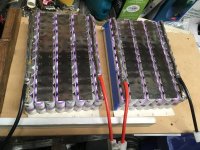I have started many engines with hobby packs.
I have a large set of heavy gauge, heavy duty Jumper Cables. Coming off of that I have 8pcs Anderson PP45's
You can start a 5.2L V8 from a single, 4Ah, tired old 20C pack....
Do it 2 or 3 times...
But I did it once and a single pouch in series lit off into a fireball
What you are concerned with is turning the motor over once the first weak cells in series drop below operating voltage. For this reason, I would use a "Lead Acid Approach" of grossly oversizing in capacity.
Doing so will give you tons more punch, will make it so that the cells are not being pushed, and will lower the likelyhood that you will experience flame-off or out-gassing.
In this particular use case (Extreme High Current for what could be 10 seconds)
I suggest focusing less on summing the C*Rate x Capacity (for rated current handling) and focusing more on the POWER TRANSFERRED and how long you can do that for.
Example
Discharge = 400A
Capacity = 6.5Ah
C-Rate = 35-55A per cell (back calculate it)
Capacity = ?
For 10 cells in parallel you would have 65Ah available (that is an ASS TON of lithium)
If you run 400A for 6 seconds. . . that is
400A for 1 hours is 400Ah
400A for 1 minute is 400Ah/60 = 6.7Ah
400A for 1 second is 112mAh
So turning over for about 6 seconds should equate to about 1% of your pack.
That is a damn-lot of margin. I would call that "dead nuts safe" to an order of magnitude.
Current per cell would be 40A. . . so for bursts like 10 seconds, that would be completely fine. Just dont turn it over for a minute and a half* (as that would bring cell heating into the equation, which you do not want to worry about)
-methods


